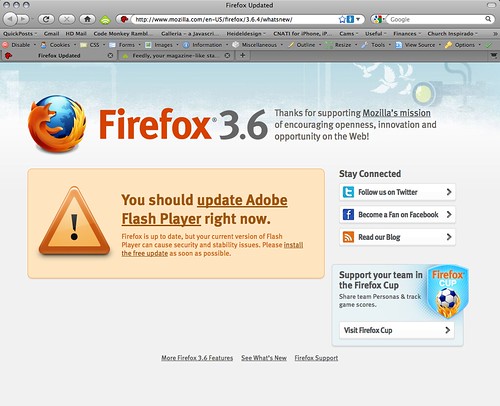The great thing about iPhones, the reason people stand in lines and upgrade before their contracts have expired, is the experience. The responsiveness of the interface and simplicity of the control scheme make iPhones the bright spots in our tech-saturated lives. Toddlers can use them. Grandparents quickly gain mastery of the devices. The most tech-savvy of us can find solace in having one piece of hardware that doesn't require obsessive maintenance.
That's not to say that there aren't occasional hiccups with iPhones. But those issues are far more likely to be a by-product of a stand-alone app. Flash, the plugin that can facilitate certain streaming media and gaming experiences on websites, is not a stand-alone app. It integrates directly with a web browser (in the iPhone's case, Safari) a core application of the device. Apple didn't create Flash and doesn't control its codebase. Because of that fact, they do not want to integrate it into the lifeblood of their device. It's that simple.
Instead of Flash, Apple has opted for the open standards of HTML5 and CSS3. They cost nothing for web developers to use and the future of the codebase is not owned by any one company. The story might have been different if Flash had a history of being a good steward of computer resources and user-interaction. Regardless of past transgressions, Flash is still a harbinger of security and stability issues. Just take the following screenshot for example:

This Firefox browser message clearly warns of stability and security. It's red. It has an exclamation point. It's scary. That's the antithesis of the iPhone.
That's not to say that there aren't occasional hiccups with iPhones. But those issues are far more likely to be a by-product of a stand-alone app. Flash, the plugin that can facilitate certain streaming media and gaming experiences on websites, is not a stand-alone app. It integrates directly with a web browser (in the iPhone's case, Safari) a core application of the device. Apple didn't create Flash and doesn't control its codebase. Because of that fact, they do not want to integrate it into the lifeblood of their device. It's that simple.
Instead of Flash, Apple has opted for the open standards of HTML5 and CSS3. They cost nothing for web developers to use and the future of the codebase is not owned by any one company. The story might have been different if Flash had a history of being a good steward of computer resources and user-interaction. Regardless of past transgressions, Flash is still a harbinger of security and stability issues. Just take the following screenshot for example:

Image by heideldesign via Flickr
This Firefox browser message clearly warns of stability and security. It's red. It has an exclamation point. It's scary. That's the antithesis of the iPhone.
